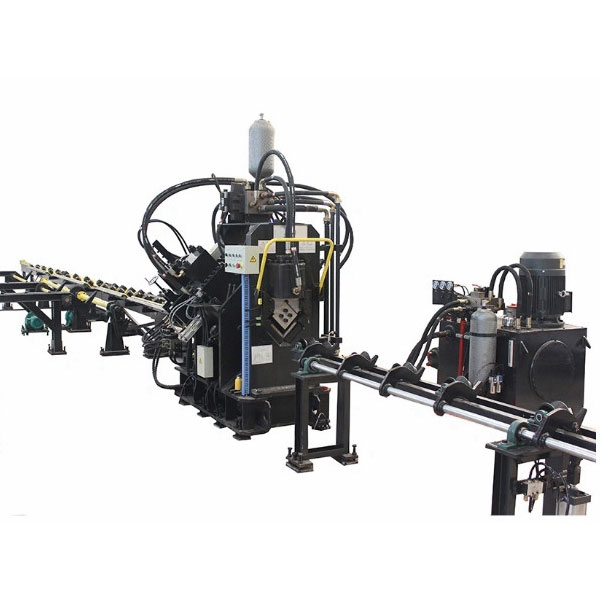Advantages of CNC Drilling Machines
2024-06-03
A CNC drilling machine is a computer-controlled machine tool used for precisely drilling holes in workpieces made of various materials such as metal, wood, plastic, and composites. It utilizes CNC technology to automate the drilling process, offering high accuracy, repeatability, and efficiency. Here's an overview of the CNC drilling machine:
Characteristics:
1. Computer Numerical Control (CNC): Equipped with a computerized control system that interprets programming instructions and controls the movement of the drilling tool and workpiece. CNC technology allows for precise positioning, speed control, and multi-axis movement.
2. Drilling Head: Contains the drilling tool(s), which may include twist drills, center drills, countersinks, or other specialized drill bits depending on the application requirements. The drilling head may have multiple spindles for simultaneous drilling of multiple holes.
3. Workholding: Features a workholding system to secure the workpiece during drilling operations. Common types of workholding devices include vises, clamps, fixtures, and vacuum tables.
4. Tool Changer: Some CNC drilling machines are equipped with automatic tool changers (ATCs) that allow for quick and seamless changing of drilling tools between operations, minimizing downtime and increasing productivity.
5. Coolant System: Many CNC drilling machines are equipped with coolant systems to lubricate and cool the drilling tool during operation, which helps to prolong tool life and improve machining efficiency.
Functionality:
1. Programming: Drilling operations are programmed using CNC software, specifying parameters such as hole diameter, depth, position, and drilling sequence.
2. Tool Setup: The appropriate drilling tool is installed in the machine's spindle and secured using the toolholder. Tool lengths and offsets are measured and entered into the CNC control system.
3. Workpiece Setup: The workpiece is securely mounted on the machine's worktable or fixture, ensuring proper alignment and stability during drilling.
4. Execution: The CNC control system executes the programmed drilling operation, controlling the spindle speed, feed rate, and tool movement to accurately drill holes in the workpiece according to the programmed specifications.
5. Quality Control: Drilled holes are inspected using precision measuring instruments such as micrometers, calipers, or optical measurement systems to ensure they meet specified tolerances and quality standards.
Applications:
1. Manufacturing: Used in various industries for drilling holes in components, parts, and assemblies, including automotive, aerospace, machinery, electronics, and construction.
2. Prototyping: CNC drilling machines are valuable tools for rapid prototyping and product development, allowing for quick iteration and testing of hole patterns and configurations.
3. Batch Production: Ideal for batch production of parts requiring consistent hole patterns, such as engine blocks, chassis components, electronic enclosures, and panel assemblies.
4. High-Precision Machining: Capable of drilling precise holes with tight tolerances in complex geometries and hard-to-reach areas of the workpiece.
Advantages:
1. Precision: CNC control ensures accurate hole positioning, size, and depth, meeting tight tolerance requirements with high repeatability.
2. Efficiency: Automation of drilling operations reduces cycle times, minimizes setup changes, and increases productivity compared to manual drilling methods.
3. Flexibility: CNC programming allows for easy adjustment of hole parameters and rapid setup changes for different workpieces and production requirements.
4. Versatility: Capable of drilling a wide range of hole sizes, shapes, and patterns in various materials, offering versatility for diverse machining applications.
Considerations:
1. Programming Skills: Operators must be proficient in CNC programming and operation to effectively utilize the machine's capabilities and optimize drilling performance.
2. Tool Selection: Proper selection and maintenance of drilling tools are essential for achieving optimal performance, hole quality, and tool life.
3. Workpiece Fixturing: Proper setup and alignment of the workpiece are critical to ensure accurate hole positioning and avoid tool/workpiece collisions.
Conclusion:
CNC drilling machines are essential tools in modern manufacturing environments, providing precise, efficient, and versatile solutions for drilling holes in a wide range of workpieces. With their advanced CNC control systems, automatic tool changers, and coolant systems, these machines offer increased productivity, flexibility, and quality compared to traditional drilling methods. Proper setup, programming, and maintenance are key to maximizing the performance and efficiency of CNC drilling machines in various machining applications.



